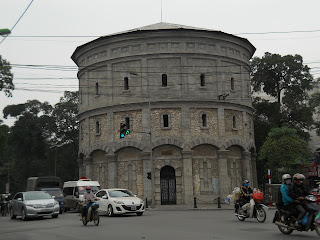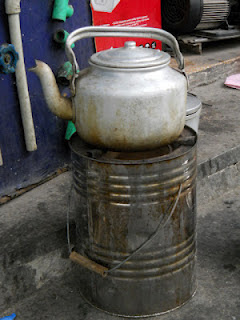 Long Bien Bus Station is located near Tran Nhat Duat; near Yen Phu; near Hang Dau; near Hang Khoai; 0.1 kilometre away from Nguyen Thien Thuat Road.
Long Bien Bus Station is located near Tran Nhat Duat; near Yen Phu; near Hang Dau; near Hang Khoai; 0.1 kilometre away from Nguyen Thien Thuat Road.A short distance northward on Yen Phu Road is an open shelter bus stop for bus number 4,8,15,17,36,50,54,55, and 58.
Hanoi city buses number 7 and 17 at Long Bien terminal connect Noi Bai Airport with Hanoi city center.
The bus stop is just on the right side of the terminal exit.
Buses run every 15-20 minutes from 5 a.m. to 10 p.m.
Bus number 7 connects the airport to Kim Ma bus station.
Bus number 17 connects the airport to Long Bien bus station.
The travelling time is about an hour tothe airport as there will be many stops long the way and packed with standing passengers as well.
Viet Hotel at Hang Than Street,Ba Dinh District. Ba Dinh is the political center of Vietnam.
Most of the government offices and embassies are located here.
It was formally called the "French Quarter" (Khu phố Pháp), Han Thanh street is the origin of Hanoi's famous green rice flake cake(Vietnamese: bánh cốm ).

Chua Hoe Nhai Zen Buddhist Temple at Hang Than Street.
Buddhists in Vietnam belong mostly to the 3 forms of Mahayana School of Buddhism - Zen Buddhism, Pure Land Buddhism and Vajrayana. Actually, it is a combination of Pure Land and Zen Buddhism that dominates Buddhist life in Vietnam.
Pure Zen practice is followed mostly by monks and nuns while Pure Land Buddhism is preferred by more common people.

View of inside compound of Chua Hoe Nhai temple which belongs to the Buddhist Soto sect.
This is one of the two major sects of Buddhism in northern Vietnam .
Moving northwest from Yen Phu bus terminal is the Truc Bach Lake adjoining Ho Tay Lake(West Lake).
Across the Sofitel Plaza Hotel towards Truc Bach Lake were many cafes and seafood restaurants which were family run.
The afternoon lunch hour was packed with locals enjoying their steamboat beside the lake.
Truc Bach Lake has appeared from the seventeenth century when people in Yen Hoa village (now called Yen Phu) and Yen Quang village (now Quan Thanh street) built a dyke to change a corner of West Lake into a small pond with purpose of breeding fish.
Truc Bach lake is also surrounded by historical sites and structures. Quan Thanh temple is situated on the southwest corner of the lake.
On the east, there is Chau Long pegoda in Chau Long street, which is said to be built in King Tran’s reign and to have been home for a princess, daughter of King Tran Nhan Tong, who led a religious life.
Also, there is An Tri temple, which is dedicated to a worship of Uy Do, a hero in a war against Nguyen invaders.
Truc Bach Lake together with Ly Tu Trong park creates a harmonious natural sight and a beautiful landscape for Hanoi capital.

View of Sofitel Plaza Hotel.
West Lake being the pride of Hanoi is the green lung of Thang Long.
Located in the northeast of Hanoi,Tay Ho district covering an area of about 500ha and a shore length of 17km.
West Lake and Truc Bach Lake originally used to be one lake but in 1620 a dam was built to separate the lakes into two by Cố Ngự dam.
West Lake is beautiful and very impressive because of its immense blue surface and full of fresh air.
In the morning the whole area could become very foggy.
Nha Khach Truc Bach at Tran Vu Street is a luxury restaurant.
The area around here has many embassies including China, Hong Kong, Singapore, Germany, Poland, Hungary and Canada.
One notable 23-storey high rise building at Dang Dung Street nearby is the Skyline Tower which has a breathtaking view of the whole lake,a 360 degree panoramic view.
The building has luxury residential apartments and commercial suites.
Thang Long Hanoi,1000 years Nam Van Hien(culture) anniversary celebration. This was the biggest celebration in Hanoi beginning 1st October 2010 lasting for 10 days with the last day being the grand Liberation Day of Hanoi.
A magnificient display of fireworks was at the My Dinh National Stadium which also features 8000 local artists showing their artwork with the theme:"Thang Long Hanoi,the city of the ascending dragons."
Tay Long 2 Floating restaurant.
Local bus No:14,33,45 and 55 stopped at Thuy Khue Street.
This Harley Davidson motorbike was fiercely decorated.
 Floating restaurant with upper terrace viewing platform.
Floating restaurant with upper terrace viewing platform.Towards the north-west of Ho Tay Lake is Sen Cultural Park West Lake Cuisine which is the biggest international buffet restaurant in Hanoi.
Location is at 614,Lac Long Quan Street at the end junction of Xuan La Street
Lac Long Quan Road is a very long stretch starting from the main road junction of An Duong Vuong-Au Road area.
Bus 25,33 and 55 do stop nearby.
Dragon Boat Tay Long 3 Restaurant.
Happy House Restaurant and Bakery on a boat docked to the south shore of Truc Bach Lake.

This one looked like a White Castle but couldn't see the restaurant name.
There is a modern Westlake Water Park towards the northern end of Tay Ho Lake quite near to the main road junction of Au Duong Vuong-Au Co.
Bus 33 and 55 bustop near side street 612 Lac Long Quan.
The waterpark was opened on the 19th My 2000 and entrance fees is 60,000 Dong on weekdays,80,000Dong on weekends.
Nha hang Du tuyen Ho tay Potomac Restaurant and Bar.
Located off Thuy Khue Street,Ho Tay. Nha Hang Dac San Banh Tom Ho Tay. Duong Than Nien Street,Ho Tay,Hanoi.
This is the most popular restaurant among the Hanoians as during lunch time it will be fully packed.
This place is famous for the Ho Tay shrimp cake.
View of Nha Hang Banh Tom dining area.
Tran Quoc Pagoda was founded on the bank of the Red River by King Ly Nam De who named it Khai Quoc (National Founder).
Much later, it was moved to its present site beside Hanoi’s Ho Tay (West) Lake during the reign of King Le Kinh Tong (1600-1618) and renamed Tran Quoc (National Defence).
The current building is the result of major renovations in 1815, but one of its effigies dates back to the early 17th century.
In the garden, there is a Pipal Tree (ficus religiosa, but known throughout history as the Bodhi tree) reputedly grown from a cutting of the original tree where Buddha sat and gained enlightenment.
Cho Chau Long is a small wet market selling fresh vegetables,marine products and sundry goods located off Tran Vu Street near Truc Bach Lake.































































